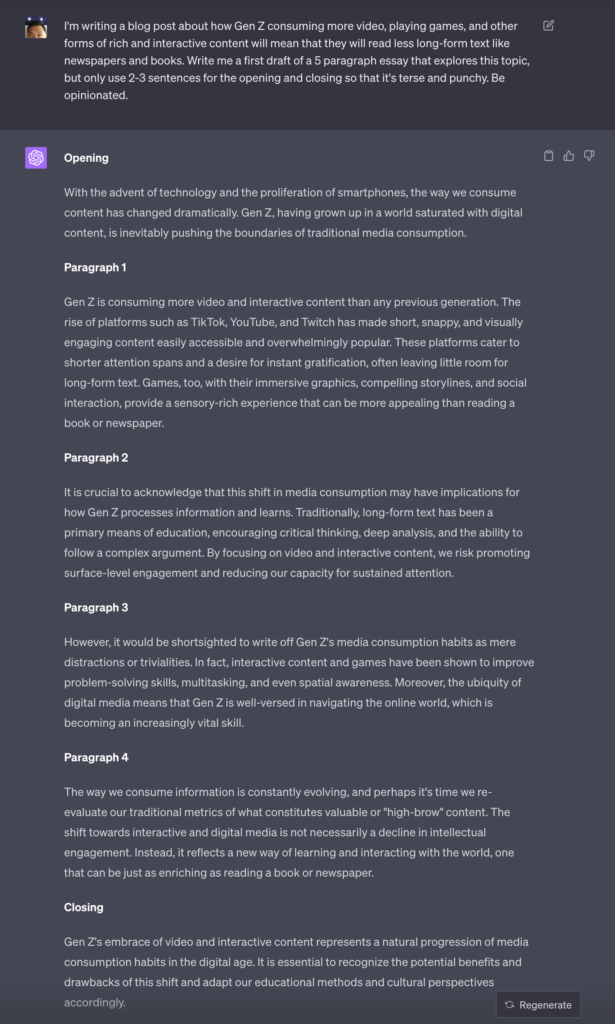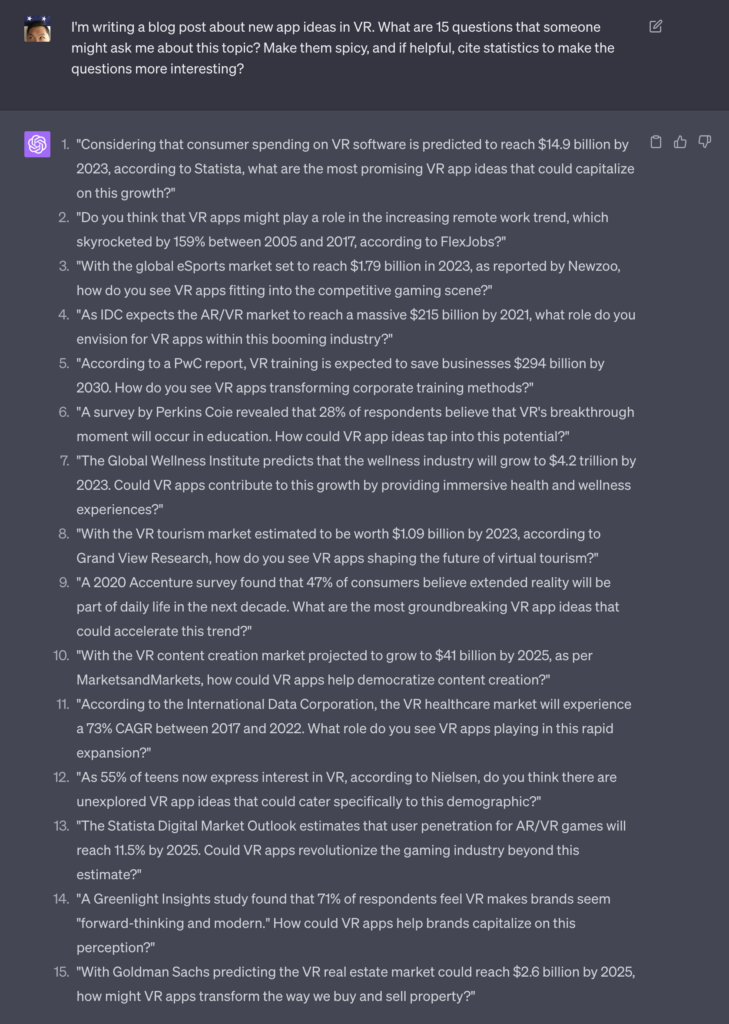
Hi readers,
Over the years, I’ve shared lessons and tips from writing a professional blog — previously 10 years of professional blogging – what I’ve learned. Recently, I’ve had some major changes in my workflow, and wanted to share more.
Pre-AI blogging workflow
My pre-AI workflow for blogging — what I’ve been doing for over years — looks something like this:
- Have interesting conversations at work or with friends/colleagues
- Randomly grab my phone, and email myself the title of a blog post
- These have punchy opinions/titles that expand easily to blog posts – some examples:
- “what needs to happen for web3 gaming to work”
- “lessons learned from launching games that apply to web and mobile apps”
- “why startups should ignore social media haterade”
- etc
- Recently, I’ve been using this app, Email Me, which is opens to a text box and it’s a one-button send (also nice for articles to read later, todo list items, etc)
- These have punchy opinions/titles that expand easily to blog posts – some examples:
- Later, when I’m doing email, I do one of two things:
- If I’m motivated, start a blog post right away with the title
- Or put it into my Notes app where I collect a long list of 100+ titles that are on the backlog
- I generally write on the weekends and try to do a full essay in one sit – usually take 2-3 hours
- Very very rarely do I go back and proof read or rewrite them (don’t blame me! I’ve been writing for hours!)
- Usually the essays are scheduled to go out Monday/Tuesday morning at 9am
- The day the post goes out, I do a light proof-read and then once it goes out, I write a tweetstorm directing traffic
This whole process has served me well for years. In the end, there’s no real magic to it — 99% of the battle is carving out a few hours on Sundays to write when there’s a many dozens of emails that need to be returned, Netflix shows to be watched, and games I should be “researching” for my job as a games industry investor.
But in the past year, I’ve experimented with changing my workflow to incorporate a number of new generative AI tools — particularly ChatGPT. I wanted to share some experiences with what it seems to be good at, and what it’s not.
Post-AI blogging workflow
After ChatGPT was released, I began to experiment with it in various ways — here are a few ways where it’s been useful.
First, writing from a blank page is hard. Sometimes it’s easier to just generate a first draft of something, even if it’s not great, just to get your creative juices going. I might use a prompt like this:
I’m writing a blog post about how Gen Z consuming more video, playing games, and other forms of rich and interactive content will mean that they will read less long-form text like newspapers and books. Write me a first draft of a 5 paragraph essay that explores this topic, but only use 2-3 sentences for the opening and closing so that it’s terse and punchy. Be opinionated.
And ChatGPT returns something that sort of makes sense? But reading the results more closely, it lacks examples and story-telling, and statistics or anything else. I don’t like Paragraph 3 here, since it misses an opportunity to talk about how much of YouTube is education purposes, for example. The writing is a bit too stiff and formal, and doesn’t match my own personal style.

In general, it’s just not that good.
But after staring at a page like this and finding all the flaws, I can then iterate pretty easily. I can put in a followup prompt to change out Paragraph 3 and connect it to a different point. Or I can just start editing it and rewriting it completely, and even if at the end 90% of it is different, it’s still better than starting with a blank page.
Brainstorming outlines, lists of topics and questions, and more
If ChatGPT is weak at actual writing, where I find it excels is as a non-judgmental brainstorming partner that doesn’t care if you have stupid ideas or if your writing is boring. It’s supremely useful for generating outlines of blog posts, making lists of topics, and creating a bunch of questions you can answer as inspiration, etc. In this use case, the AI doesn’t have to have a 100% hit rate on its content. If it creates lists and lists of content, but 20% inspires you in your actual work, then that’s a success.
For example, let’s say that you know you want to write a blog post about opportunities to build new apps in VR. You can ask something like:
I’m writing a blog post about new app ideas in VR. What are 15 questions that someone might ask me about this topic? Make them spicy, and if helpful, cite statistics to make the questions more interesting
It comes back with a mishmash of questions, some which are dumb and uninteresting — like the first, one, which is just asking what VR apps will be useful. But it also has a bunch of interesting ones on esports, content creation, corporate training, etc.

You could also imagine using this as a pretty helpful tool if you are making a new podcast and are interviewing guests. Or if you want to write a new essay that critiques some existing paradigm. (“Give me 10 questions from someone who is skeptical of of the value of AI safety”). And once you have an interesting question, it becomes easy to ask it to outline an entire blog post about it.
For example, I often find it useful to write prompts for outlines specifying specific topics and ideas.
Take the concept of K-12 education and VR – can you write an outline expanding on the promise and also skepticism around this idea? In particular touch on the concept of blending entertaining and gaming and learning, as one of the points. Create 6 sections, and put 3 sub-bullets under each. Use strong opinions and ask tough questions.
I’ll leave it to an exercise for the reader, but the result is not bad. It’s a decent starting point.
ChatGPT works great for outlines for long form writing also. And as many of you know, I wrote my book 3 years ago without the benefit of AI. The book is on network effects, and I ended up making an outline that acts in various stages, and uses examples from iconic tech companies. I can prompt ChatGPT with something like this:
Create an outline for a book on network effects for mobile apps and websites. Stage out the outline so that it starts on launching a product from zero, and the issues there, versus the stages of scaling the product, then hitting market saturation. Make sure you are able to weave in the issues facing network effects-driven products like social networks, marketplaces, dating apps, and collaboration tools. Write a 10 section book, with 3-5 sub-bullets. The first sub-bullet in each section should always be an example of an iconic tech company, like Uber, Airbnb, Dropbox, Tinder, Slack, or others. Please make the comprehensive outline for a book focused on network effects targeted at professionals working in the tech industry
The result actually isn’t bad. It’s not the way that I wrote it, since it starts to dive into each category of product rather than expanding on the broad concept. But again, it’s not a bad starting point. I could easily have imagined using this for brainstorming and prototyping purposes, iterating through different versions in describing the idea. It might have helped me work at more of a conceptual level in the early months, without getting dragged into the minutiae of writing all the various sentences.
Cleanup — at the beginning, and at the end
Finally, one of the tips I have for folks who are struggling with writing is to simply talk out their ideas aloud. Some of us are often more verbally wired, and we will connect disparate ideas and make interesting connections when asked a question, but flop when we’re just staring at a blank text. The voice feature in ChatGPT’s mobile app — and also products like Oasis AI — are interesting in that you can go stream of consciousness on a topic, and these products can clean them up significantly. The output isn’t that usable, IMHO, but you can then go and add/edit the result and develop it further.
It’s powerful when you combine this with AI-generated outlines. Just give ChatGPT a topic or better yet, an opinion (“open source products have bad consumer UX!”) and have it come up with an outline of the argument. Then start talking through the argument, and record it. Process it in one of the new AI apps, and then get it down to text. Then edit from there.
The other place where AI-driven cleanup can help is at the end, if you want to make sure you sound professional, or like an expert, and not an idiot. You can have ChatGPT rewrite content and incorporate a different tone. Or feed it some examples to cite and build off of. The ability to clean up ideas and textual content during and then after the creation flow is all pretty interesting.
There’s a bunch of things ChatGPT can’t yet do
I’m excited for all the ways that generative AI will help the writing process. I find edges to its capabilities that will soon be addressed, I’m sure. But here are some obvious ones that I notice all the time:
- I want it to have all the data, up to today (or in real-time), because I want it to use examples and cite numbers that are as recent as possible
- Some genAI tools can generate images, which is useful, since I want to create charts and figures, sketches of concepts, and even the little lead image that sits on top of each essay
- It’d be ideal if it was connected to Twitter and other social media platforms, so that you could tweet out content easily — writing tweetstorms via AI would be great!
- I want to train it on a corpus of my own writing, of course, and also writers that I respect. Right now it takes some work to customize the tone of voice to what I want
- There’s data, documents, and other info that I want to feed into ChatGPT, and then have it utilize the content as part of its arguments and suggestions. Imagine a routine task like, “hey, take this 10,000 word chapter and summarize it into a 100 entry tweetstorm” would be hugely helpful. Right now it can’t do that
There’s a lot more to go here, but it’s incredibly promising.
When I’m blogging these days, no wonder I find myself with WordPress open in one window, and then ChatGPT in the other. And I find myself spinning up new chats, copying and pasting back and forth. It’s the first time in 10+ years that I’ve found my workflow significantly change, and I’m excited to see what happens next.
PS. Get new updates/analysis on tech and startups
I write a high-quality, weekly newsletter covering what’s happening in Silicon Valley, focused on startups, marketing, and mobile.
Views expressed in “content” (including posts, podcasts, videos) linked on this website or posted in social media and other platforms (collectively, “content distribution outlets”) are my own and are not the views of AH Capital Management, L.L.C. (“a16z”) or its respective affiliates. AH Capital Management is an investment adviser registered with the Securities and Exchange Commission. Registration as an investment adviser does not imply any special skill or training. The posts are not directed to any investors or potential investors, and do not constitute an offer to sell — or a solicitation of an offer to buy — any securities, and may not be used or relied upon in evaluating the merits of any investment.
The content should not be construed as or relied upon in any manner as investment, legal, tax, or other advice. You should consult your own advisers as to legal, business, tax, and other related matters concerning any investment. Any projections, estimates, forecasts, targets, prospects and/or opinions expressed in these materials are subject to change without notice and may differ or be contrary to opinions expressed by others. Any charts provided here are for informational purposes only, and should not be relied upon when making any investment decision. Certain information contained in here has been obtained from third-party sources. While taken from sources believed to be reliable, I have not independently verified such information and makes no representations about the enduring accuracy of the information or its appropriateness for a given situation. The content speaks only as of the date indicated.
Under no circumstances should any posts or other information provided on this website — or on associated content distribution outlets — be construed as an offer soliciting the purchase or sale of any security or interest in any pooled investment vehicle sponsored, discussed, or mentioned by a16z personnel. Nor should it be construed as an offer to provide investment advisory services; an offer to invest in an a16z-managed pooled investment vehicle will be made separately and only by means of the confidential offering documents of the specific pooled investment vehicles — which should be read in their entirety, and only to those who, among other requirements, meet certain qualifications under federal securities laws. Such investors, defined as accredited investors and qualified purchasers, are generally deemed capable of evaluating the merits and risks of prospective investments and financial matters. There can be no assurances that a16z’s investment objectives will be achieved or investment strategies will be successful. Any investment in a vehicle managed by a16z involves a high degree of risk including the risk that the entire amount invested is lost. Any investments or portfolio companies mentioned, referred to, or described are not representative of all investments in vehicles managed by a16z and there can be no assurance that the investments will be profitable or that other investments made in the future will have similar characteristics or results. A list of investments made by funds managed by a16z is available at https://a16z.com/investments/.
Excluded from this list are investments for which the issuer has not provided permission for a16z to disclose publicly as well as unannounced investments in publicly traded digital assets. Past results of Andreessen Horowitz’s investments, pooled investment vehicles, or investment strategies are not necessarily indicative of future results. Please see https://a16z.com/disclosures for additional important information.